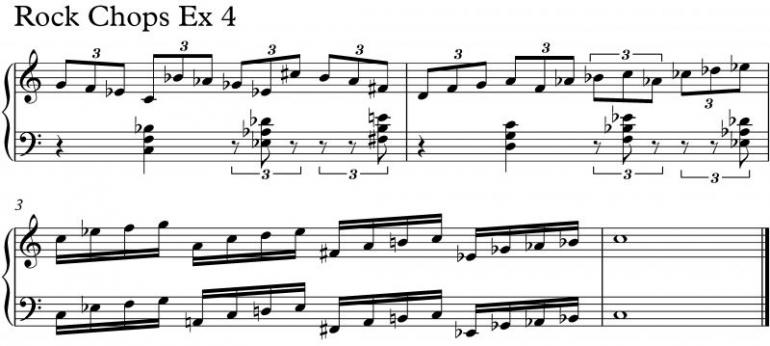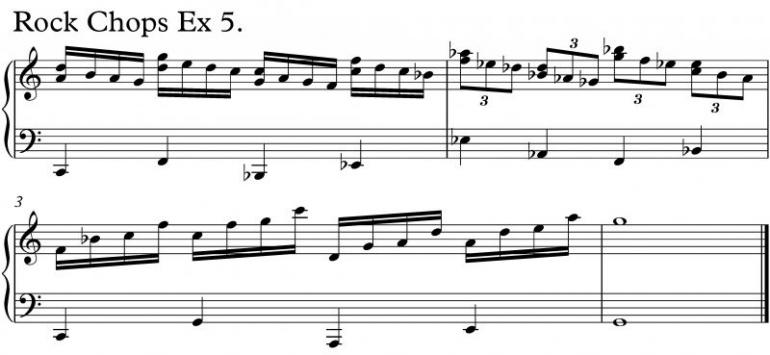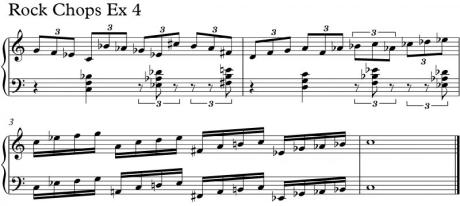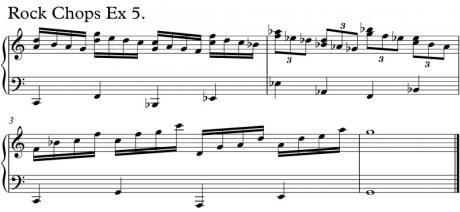Rock Organ XVII - Rock Chops

Čtenáři, možná vás zaskočí, že na českých stránkách nacházíte anglický text. Není to chyba. V současné době pro časopis Muzikus píše newyorkský klávesista a pianista Brian Charette. A tak jsem si v redakci řekli, že bychom mohli něco udělat pro zlepšení vašich znalostí angličtiny. Určitě nám dáte za pravdu, že angličtina se na pódiích objevuje stále častěji a potřeba domluvit se na pódiu i v zákulisí se stane brzy samozřejmosti. Proto zde naleznete originální verzi přímo od Briana a na stránkách časopisu Muzikus v čísle 11/2013 článek přeložený Petrem Štikou. Navíc zde máte audio ukázky, které do časopisu jaksi přeložit neumíme. Enjoy reading!
šéfredaktor časopisu Muzikus Ing. Vladimír Švanda
This month I wanted to give you some two handed technical exercises to give you some wicked ideas to throw into your keyboard solos. The exercises are given in one key but are meant to be taken through all twelve keys. Figure our the theory of whats happening in the examples and raise the key center by 5ths trying to incorporate the ideas in each key. This process is the key to mastery of the techniques. I don't like to write fingerings in because I like each individual player to come up with their own fingerings. The exercises are actually quite easy to finger even though they can be a little quick.
Ex. 1 Pentatonic Skip
Next time you do a pentatonic lick, try putting a skip in your pattern. This adds a little space between the line and creates interesting 4th intervals automatically. In the first two bars of our C minor pentatonic riff (C, Eb, F, G, Bb, C), we begin a descending line on Eb and, on our way down, skip the next note in series, C. We follow the scale down to F then jump up to the note we skipped and repeat the pattern skipping the 2nd note in the sequence. Do this in both hands as well so you get a well rounded workout :). In bar 3, we switch to 4th shapes built from notes in the C dorian mode (C, D, Eb, F, G, A, Bb, C) in triplets. Try these lines over Cm7 and F7 harmony or Cm rock vamps.

Ex. 2 Diatonic Contrary Motion
This example takes advantage of the key of the people; C. Diatonic minor 7th chords move in contrary motion. Bar one begins with a D minor 7th chord arpeggio. The right hand starts from the C and goes down, the left hand starts on D and goes up. The Arpeggios descend diatonically in the key of C keeping the same four note pattern. The challenge is to be able to do this in all the keys! Practice those teo handed major scales in all twelve keys so you can really "see" the notes in each key. Bars 3 and 4 harmonize a C Major Scale in thirds. The right hand mirrors the motion of the left starting a 3rd above for a nice harmony.

Ex. 3
This twisty exercise uses the symmetry of the C diminished scale (C, Db, Eb, E, F#, G, A, Bb). you can kind of use this riff in any key because it moves in minor 3rds making it sound a little out. It works best in C vamps though. The eighth note arpeggios are also grouped in 5 to add to the interest. At the end of bar 2, we add one extra eighth note so the rhythm comes out on 1 for Bar 3. In the last 2 bars we just repeat the 5 note motif without moving in minor thirds. For extra credit, try voicing your left hand a 3rd up or down from the right hand for a crazy harmony.

Ex. 4
Here we have another kind of grouping, a rhythmic one. By grouping triplets in 4, we give the impression of a new meter over the original one. This is called metric modulation. Notice how 3 "measures" of the new 4 fit in one bar. The first bar has an descending version while bar two has an ascending one. the chords again move in minor thirds splitting the octave into 4 symmetrical pieces. The righthand material is minor pentatonic scales moving in minor thirds. The left hand plays 4th chord accents on the last note of each motif for added rhythmic counterpoint. The last bar goes back into a quick 16th note fantasia in the original time feel before resting on tonic.

Ex. 5 Fourths and Fifths
This example has repetitive shapes with harmony moving in fourths and fifths. Bar one has triadic shapes with the addition on a 9th moving over bass notes a fifth down. Notice that by playing a simple triadic shape over a different bass note we get an interesting chord; Gadd9/C or CMaj13 no 3 in beat one. The harmony moves up a fourth then down a fifth as the bar progresses. In the second bar we have a similar idea with triplets; this time the bass note is one step above the tonic of each chord creating 7 sus4 chords. Bar three has a Keith Emerson inspired sus 4 arpeggio moving over bass notes a fourth below the tonic creating nice minor11th shapes before resting on a G unison in the final bar.









